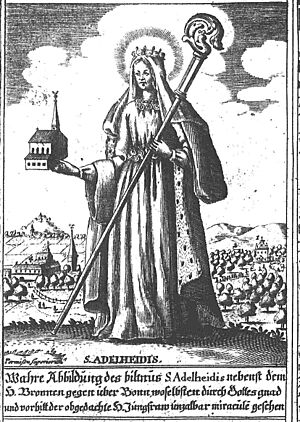Adelaide, Abbess of Vilich facts for kids
Quick facts for kids SaintAdelaide of Vilich |
|
|---|---|

Adelaide, Abbess of Vilich, detail from a pilgrim sheet, 1718
|
|
| Abbess of Vilich | |
| Born | c. 970 |
| Died | 5 February 1015 Cologne, Germany |
| Venerated in | Roman Catholicism, Eastern Orthodoxy |
| Feast | 5 February |
Saint Adelaide of Vilich (born around 970, died February 5, 1015) was an important abbess in Germany. She led two convents: Vilich and St. Maria im Kapitol in Cologne. After she died, people remembered her for the amazing miracles linked to her. Her parents, Count Megingoz and Gerberga, also founded the Vilich convent. We learn about her life mostly from a special book called Vita Adelheidis.
Contents
Her Early Life and Becoming an Abbess
Adelaide was born around 970. She was the youngest daughter of Count Megingoz and Gerberga. When she was a child, her parents sent her to the St. Ursula convent in Cologne. There, she received her education and studied philosophy.
In 977, her older brother Godfrey died in battle. To honor him, her parents started building a church in Vilich. They also wanted to create a new community for women there. They brought Adelaide back from St. Ursula's. Then, they made her the leader, or abbess, of this new community in Vilich.
Vilich Convent and Its Rules
Adelaide's parents wanted Vilich to have a special legal status. In 987, they asked Emperor Otto III for a charter. This charter would give Vilich the same important status as other big convents. Pope Gregory VI later confirmed this charter in 996.
Around 995, Adelaide's mother, Gerberga, passed away. Adelaide then had to lead the Vilich convent by herself. She decided to change the rules of the convent to the Rule of Saint Benedict. Some of the women living there did not like this change and left Vilich.
Three years after her mother's death, Adelaide's father also died. He was buried next to his wife in Vilich. Adelaide inherited a lot of her family's money. She used some of it to buy land for the convent. The rest of the money she gave to people in need.
Leading Two Convents
Around the year 1000, Adelaide's sister, Bertrada, who was abbess of St. Mary in the Capitol in Cologne, died. Archbishop Heribert of Cologne wanted Adelaide to take over that abbey too. At first, Adelaide said no because Vilich and St. Mary's were far apart.
But Archbishop Heribert really wanted her to lead both. He contacted the emperor, either Otto III or Henry II. Adelaide was then called to the court and confirmed as the new abbess of St. Mary in the Capitol.
Adelaide's new role meant her good deeds became well-known in Cologne. Her reputation grew even more after several years of bad harvests. During these tough times, Adelaide helped many people in Cologne. While she had a good relationship with Archbishop Heribert, the sisters at Vilich felt a bit neglected. This was because Adelaide spent more time in Cologne.
On February 5, 1015, Adelaide died from a sore throat. Archbishop Heribert was with her. Her sisters from Vilich did not believe she was ill and arrived after she had passed away. Archbishop Heribert wanted to bury her in Cologne. However, the sisters convinced him to bury her in Vilich instead.
Her Veneration and Miracles
During Adelaide's time, the area around Cologne faced famines. She prayed for the poorest people. Because of her prayers, a water source appeared in Pützchen, which is now part of Bonn. This source became a well and a very important place for pilgrims.
Even today, this fountain is still there. Every September, people make a pilgrimage to honor Adelaide. In 1641, her grave was opened, but it was empty. After this, fewer pilgrims came, but some relics are still shown to the public each year.
Other miracles were also said to have happened at her grave. Adelaide was declared a Servant of God in 1922. She was officially made a saint by Pope Paul VI in 1966. February 5, the day she died, was confirmed as her official feast day.
Today, several churches, monasteries, and schools in Bonn and Cologne are named after her. On September 8, 2008, Adelaide was named the third patron saint of Bonn.
See also
- Catholic Church in Germany
- List of Catholic saints

